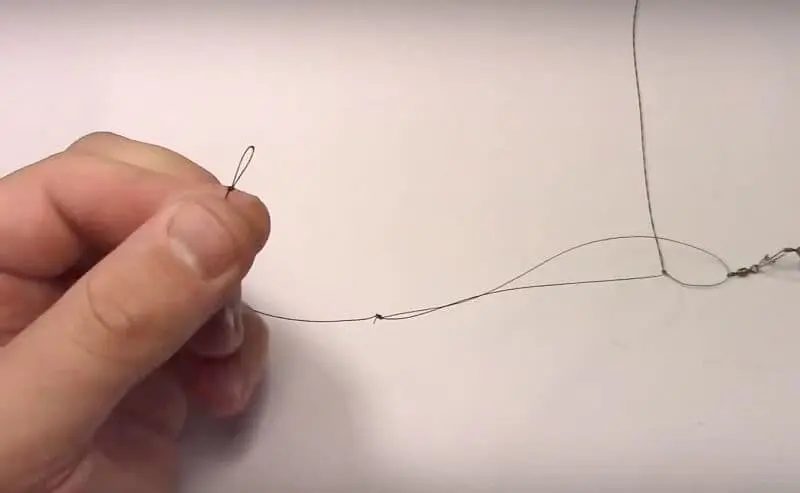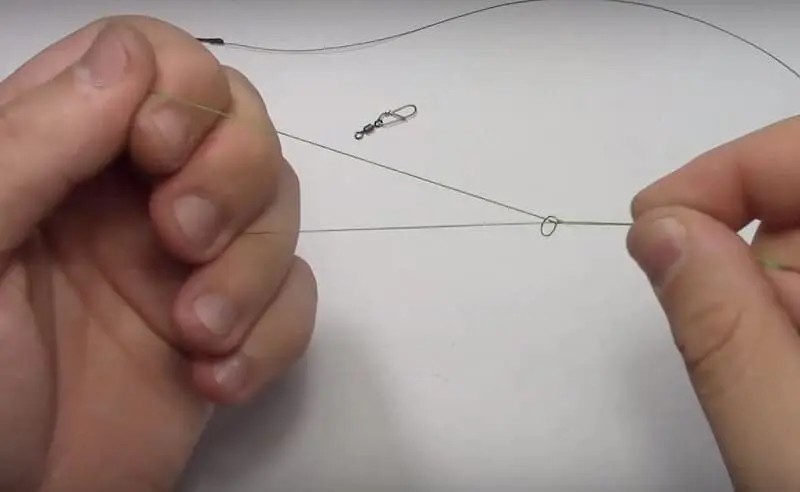Contents
The leash loop on the line is a convenient and practical device for attaching a small diameter leash line to a thicker main line. This type of connection between the main line and the leash has a number of advantages compared to conventional knots: for example, if you tie the leash to the main line by a loop, when casting, it will twist, tangle and overlap the main line less; replacing the leash does not require knitting labor-intensive knots; if desired, you can tie a second leash of a different length to the loop. Thanks to these advantages, the loop connection is used in various types of fishing: from traditional float, feeder to sports spinning and carp.
That is why it is necessary to know how to firmly tie the leash and make a reliable loop for attaching the leash.
Types of loops
Ordinary (oak)
Making such a simple and durable loop for a leash on the main fishing line as an “oak” (ordinary) one is quite easy:
- From a fishing line folded in half, a simple loop is made a little larger than planned;
- The base of the resulting loop y is fixed with the right hand;
- The upper part of a simple loop (top) is taken with the left hand and shifted to its base;
- After that, the top starts behind a double fishing line and is passed into the ring formed during such manipulations;
- The loop is formed by uniform and slow pulling of its base and top in different directions.
Such a simple and fairly quickly obtained loop is highly reliable and rarely diverges.

English (fishing)
To make such a loop for a leash on a fishing line as “English” (fishing) is necessary as follows:
- At the end, a simple cross loop is made.
- The base of the resulting loop is fixed between the fingers of the left hand.
- The end is threaded into the space between the thumb and forefinger. This creates a smaller loop.
- The manipulations described above are repeated, with the only difference being that the fishing line is wound up and passed between the thumb and forefinger in such a way that another loop is located between the original large and extreme small.
- The small outer loop is passed into the original large loop.
- Pulling the top of this loop and the main loop form a loop.
Surgical
The easiest way to make such a loop for a leash on a fishing line as a surgical one consists of the following manipulations:
- A simple loop made from a double fishing line with its top winds up behind it;
- The top of the loop is overlapped through a double fishing line and passed twice into the ring formed during the previous operation;
- By pulling the top and base, a strong and reliable loop is obtained, fixed by a surgical knot.
Video: How to tie a surgical loop on a fishing line for a leash
In addition to the loop described above, the surgical knot is used to tie hooks and leashes to leashes.
Eight
In order to make such a loop for a leash as a figure eight on a fishing line, you need:
- Fold the line in half;
- In the place where it is planned to make a knot to fix the knot, a small simple cross loop (ringlet) is made;
- The loop fixed between the index and thumb of the left hand is taken by the top and rotated about its axis by 3600. The direction of rotation is chosen so that the loop twists and does not unwind.
- The top of a large loop of a double line is passed into a small loop;
- By pulling on the top of the large loop and the base, a figure-eight knot is obtained.
Due to the strength and non-extensibility of the knot, such a loop is used when knitting various feeder and carp rigs.
Loop for attaching side leash
It is quite simple to make such a loop for a side leash on a fishing line as a stationary one by performing the following manipulations:
- In the place where it is planned to attach a side leash to the main line, a simple cross loop 10-12 cm long is made;
- The base is clamped between the fingers of the left hand;
- The top is taken with the right hand and thrown over the left hand;
- Then the top is intercepted with the left hand, the base is fixed with the right;
- The top goes down, after which the base is again intercepted with the left hand;
- 4-5 turns are performed in this way;
- After a gap has formed in the middle of the twist as a result of the performed revolutions, the top of the loop is passed into it;
- Pulling the fishing line in opposite directions, the knot is tightened and a compact loop is formed for the side leash.
Useful Tips
- It is convenient and quick to knit loops on a fishing line for a leash with such a device as a loop tie – a plastic or metal hook of a special shape that allows you to make knots of a certain length. Home-made or factory loop knitting allows you to get the most durable and compact knots, it can also be used to connect the main and lead fishing lines together.
- In many pictures and video instructions, a drop is depicted – this means that in order to avoid burning the soft nylon monofilament, it should be moistened with water. When using a braided cord as a base, it is not necessary to moisten the tightened knot.
- To tighten the loops, you must have a hard round plastic or wooden stick on hand. It is inserted into the top of the loop when tightening, so as not to injure the fingers. It is undesirable to use metal objects that have edges or edges – when tightening the knots at the base of the loop, the metal can create scratches or cuts on the soft nylon, which, under heavy loads, can cause the line in the loop to break.
- When knitting loops, at the end of the fishing line, on the tip remaining when tightened, before cutting it 2-3 cm above the place where the main knot will be, a small simple knot should be made. Its main purpose is to “insure” the loop from stretching when the knot is loosened.

Conclusion
Thus, a loop for a leash made on the main line is the convenience, strength and reliability of the equipment in which this type of connection is used. This is achieved with the help of various knots that allow you to quickly and effortlessly make comfortable and necessary length loops for tying a leash to them. At the same time, they can be knitted both manually and with the help of such a factory or home-made device as a loop tie.









